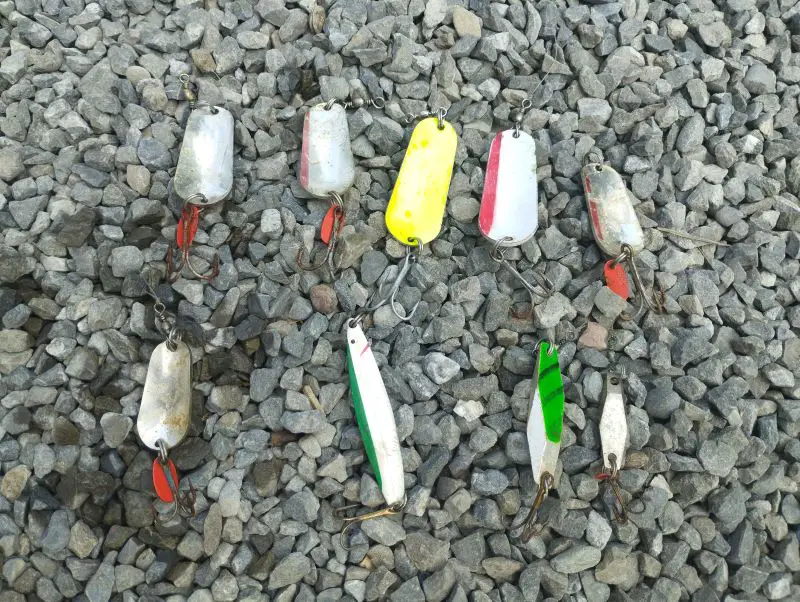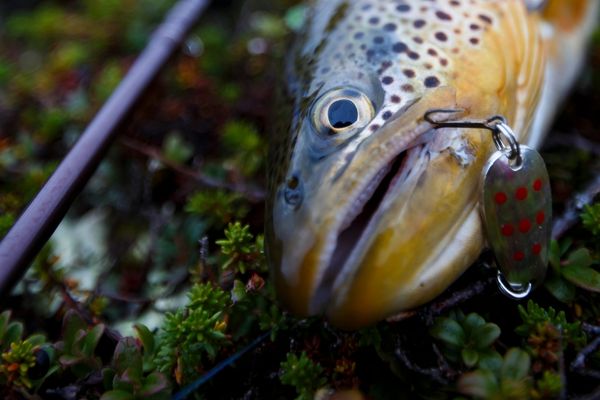The trout we see feeding at or the near the surface is usually only a tiny fraction of the total number of fish in a river. The majority of them are laying low in the water column, hugging the bottom, these trout are all but invisible from the surface.
In most rivers and ponds, a lot of trout just ‘wait’ on the bottom near the very head of pools. The water above them is fast flowing and usually turbulent, but the deeper water is actually quite slow. I have swum in plenty of deep trout pools, and have often been surprised to see the size and number of trout lurking in such locations..
At some time of year, they are also joined by migratory fish such as salmon and steelhead.
These trout, are difficult to catch. Not because they are cunning, or line shy, but because it is very difficult to get a spinner or lure down fast enough to reach where they are holding. To add to the difficulty, most of the time these trout are not actively feeding, they are usually just resting.
This means they are very reluctant to move any sort of distance to grab a lure swinging by. It almost has to hit them right in the face to get any kind of response.
In this article, I will discuss the lures, mostly spoons that I find work best in deep, fast water.

Spoons that I recommend and use.
There are too many trout spoons on the market to know them all well, so I will suggest the spoons that work best for me. I am certain there are other just as capable spoons out there that I have simply not had a chance to try.
I also will note that all these spoons catch not only trout but also steelhead and salmon. Some of them are probably more popular among steelhead anglers than trout fishermen. At the end of the day, steelhead are trout so the same gear works well enough.
One of my favorites is the BC Steel, the best part is that it comes in various thicknesses. When fishing deep, you want to go for the thickest version possible.
BC steel
The BC steel is one of my favorite trout spoons, they are made from premium material and have a very responsive action. The metal coatings are also very high quality and reflect the light well. If I do have some complaints, is that they can be quite hard to find, are pricy, and the color selection is limited. If budget and availability were not a consideration, I probably will only fish BC steel spoons when I want plain colors.
Acme Little Cleo
The next spoon I want to recommend is much more widely available, it is the Acme Little Cleo. The little Cleo like the name suggests is thick, chubby, and little. It works extremely well in deep fast water.
Thomas Rough Ride
When a little more casting distance is required, I like the Thomas Rough Rider. This solid brass lure has a more elongated shape that allows it to fly through the air or dive into the water more quickly I feel the more oval options above do have a slightly better-fluttering action, but the Thomas Rough Rider dives better and flies further.
Inline spinners can also work
Enough spoons, I will now discuss a few spinners I like to use in deep water. Spinners in my experience do not get down quite as quick as spoons, but they are a bit more user friendly on the retrieve. My favorite two spinners for deep water are the Blue Fox Vibrax and the Panther Martin, both excellent options.
The Savage Gear Caviar spinner are also an interesting because they include a tungsten ball, while I have not had a ton of experience fishing them. They too will likely be an excellent deep running lure.
Why not just use larger heavier lures?
One of the easiest ways to get deep fast is to simply use a heavier lure. A 1oz lure certainly sinks a lot faster than a lure that weighs 1/16oz. But just going heavier is not without disadvantages.
The difficulty starts, in that the trout are still trout and they are more likely to reject or ignore a large lure than a small one. To maximize the chance of hooking up, fishing smaller lures usually out catches large ones.
When I was still learning, I was given the following advice “Select the thickets, smallest spoon possible”. Thick spoons sink faster and reach the bottom first.
I also will add that spoons made out of solid brass are significantly heavier than ones made out of stainless steel. The very cheap, usually Chinese made spoons are often stainless, they feel noticeably lighter in the hand.
When fishing deep a small and dense spoon, usually catches wide and buoyant. Sorry, Thomas Bouyant, Acme Phoebes you might be excellent spoons for shallow ripples, but you simply do not make the cut when fishing deep.
Stacking spoons
One trick I was shown a few years is to stack or layer two spoons on top of each and secure them together with split rings, this creates a lure double the mass but with basically the same surface area.
This is a useful little technique to know to get a lure down deep fast, and can be useful to use when the spoons you have avaiable are not quite sinking fast enough to get into the strike zone.
Aditional informaiton
- Click here for 10 of the best spoons for trout fishing
- Click here for more information on trout fishing with spinners

